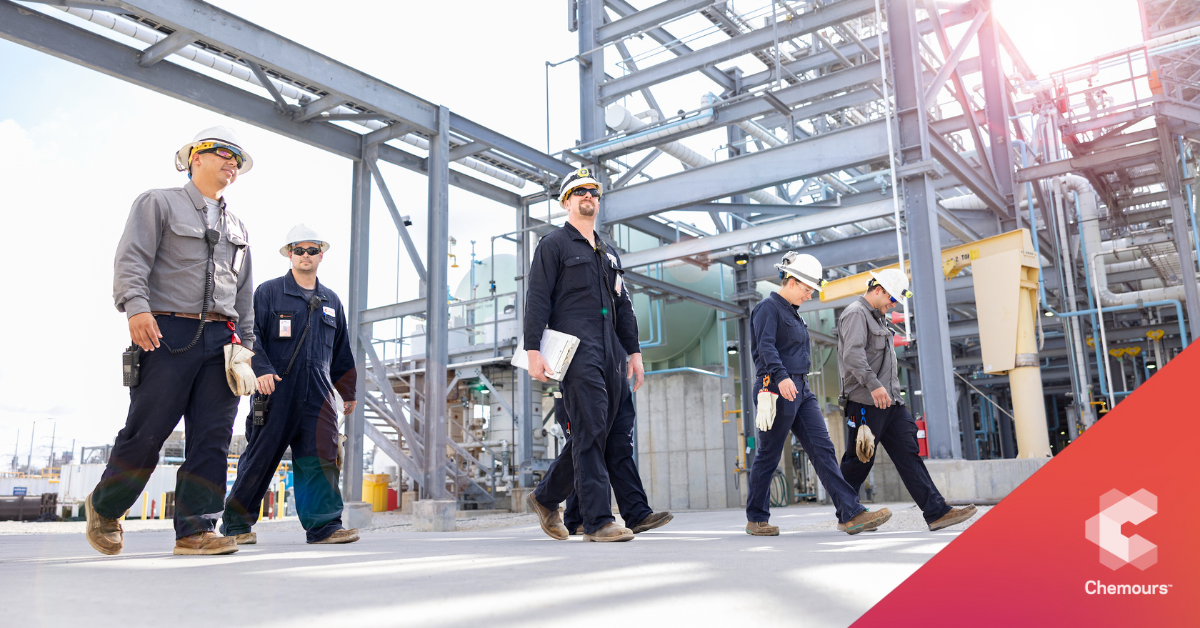Chemours’ Approach to Energy and Climate

Responsible manufacturing and environmental stewardship are inherent to Chemours’ vision of trusted chemistry and a strategic imperative to strengthening our long-term outlook. Sustainable operations help ensure that both our business and our planet thrive over the long term. We continue to invest in technologies and operational improvements at our manufacturing sites to deliver our commitments to manufacturing our products responsibly, reducing operational emissions, and incorporating circular principles.
To deliver the meaningful reductions needed to avoid the worst impacts of climate change, we must reduce our own emissions and influence our value chain to do the same. We have set absolute emissions-reduction goals that align our climate commitment with the science-based targets needed to meet the goals of the Paris Agreement and United Nations Sustainable Development Goal (UN SDG) 13.
We are reducing Scope 1 and 2 greenhouse gas (GHG) emissions from our operations by improving resource use, increasing energy efficiency, deploying lower emission technologies at manufacturing sites, and increasing use of renewable electricity. We define operations GHG emissions as the sum of our Scope 1 direct emissions and Scope 2 indirect purchased energy emissions.
Our Scope 1 and Scope 2 energy emissions are addressed primarily through improving energy efficiency and sourcing renewable power. In parallel, we also continue to develop our roadmap to net zero by chartering Sustainability Technology teams to identify new decarbonization levers. These teams meet regularly to assess appropriate changes for each region and technology and to find ways to improve energy efficiency as well as transition to either electric equipment powered by renewable electricity or low-carbon thermal solutions, such as hydrogen. For example, the Renewable Thermal charter investigates low-carbon fuels, feedstocks, and energy sources, while the Electrification charter looks at our ability to shift energy needs to electric sources paired with renewable power.
We are pursuing reductions in our Scope 3 emissions by partnering with our suppliers and customers and bringing low-carbon products to market. Activities connected to various sources of Scope 3 emissions occur along our value chain, such as the GHG emissions generated to produce the goods we purchase and use of our products by customers and their own customers.
Chemours is committed to developing products and processes that offer emissions-reduction benefits to our customers by providing market options for select products with lower GHG footprints.
2024 Actions Toward a Low-Carbon Future
SBTi Approval of GHG Targets
In 2024, the Science Based Target initiative (SBTi) approved Chemours’ near-term science-based GHG emissions reduction targets. This includes our existing goal of an absolute 60% reduction in Scope 1 and 2 GHG emissions from our operations by 2030 and a new Scope 3 target, announced in 2024, to reduce emissions by 25% per ton of production by 2030.
We have achieved a 52% reduction in operational GHG emissions since 2018—on track for a 60% absolute reduction by 2030. Despite a 4% increase in production, we maintained a downward trend in operational emission levels, achieving a reduction of about 25,000 metric tons of carbon dioxide equivalent (MT CO2e) compared to 2023. Emissions reductions are primarily due to energy efficiency improvements, renewable power initiatives, and the implementation of process emissions abatement technology. We continue to invest in technologies and advance projects to further reduce our carbon footprint and offset production growth, in pursuit of achieving our 2030 emissions targets.
This is the first year that we have reported results for our Scope 3 emissions goal. We based our Scope 3 inventory on the GHG Protocol for Corporate Value Chain (Scope 3) Accounting and Reporting Standard. The majority of Scope 3 indirect GHG emissions associated with our operations are due to customer use of our refrigerant products.
Advancing Energy Efficiency
Our Energy Efficiency Team sets annual improvement targets and develops and executes plans to achieve year-over-year energy intensity reductions. In 2024, 42 identified projects were executed that resulted in savings of over 300,000 megawatt hours (MWh) and 58,000 MT CO2e. These projects were monitored utilizing a dashboard process to demonstrate progress on a site- and company-level energy basis. Project execution was utilized as an Annual Incentive Plan metric for director-level and above positions.
Smart Steam Management for Energy Efficiency
Steam system inefficiencies have long impacted both daily energy consumption and operational expenses at manufacturing sites. In 2024, several of our U.S. manufacturing sites implemented strategic improvements to tackle this issue.
- Our Chambers Works site in New Jersey upgraded its steam system infrastructure by installing more reliable drip legs and valving and utilizing cyclic shutdowns for routine maintenance, reducing annual steam use by 8%, saving approximately 19,000 MWh of energy, and avoiding around 3,500 MT CO2e.
- At our Corpus Christi site in Texas, a Steam Trap Program has delivered measurable progress in energy efficiency and operational reliability through the implementation of a targeted maintenance strategy that minimizes steam loss and enhances system responsiveness. This initiative, which is part of a broader energy optimization effort, is projected to contribute up to 7,000 MWh in steam savings.
- Our teams at Washington Works and Chambers Works centralized their sitewide data into visual dashboards. This digital system enables teams to swiftly and efficiently pinpoint steam leaks, streamlining communication and contributing to a combined annual variable cost reduction of $980,000 across both sites.
- Similarly, our Fayetteville Works in North Carolina piloted wireless steam trap monitoring that provides real-time insights into performance and proactively flags potential failures. The pilot project at Fayetteville Works, which involved equipping just 2.5% of its steam traps with online monitoring, delivered around $70,000 in recurring annual savings. Following this success, Fayetteville Works plans to expand this technology to additional steam lines, inspiring similar digitization efforts across other manufacturing sites.
Collectively, these ongoing efforts are advancing our commitment to enhance energy efficiency and deliver high-quality specialty products with less energy usage and lower emissions.
Read more in Chemours’ latest Sustainability Report.

